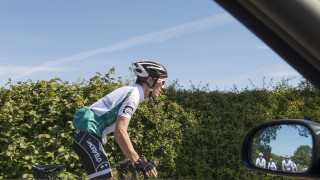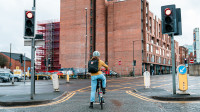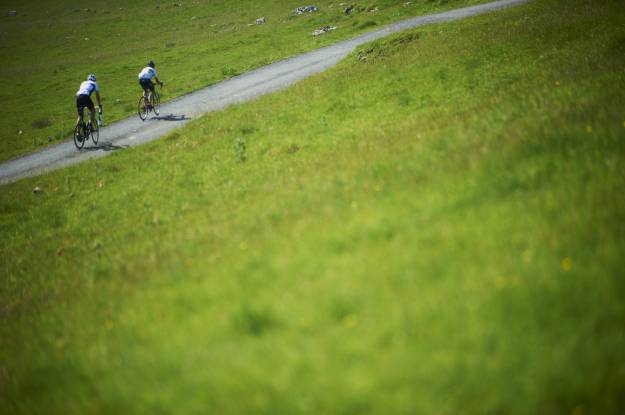Knowledge Level: Beginner
The three rear pockets in your jersey and maybe a small saddlebag give you plenty of room to carry everything you need to fix punctures, sort out minor mechanicals, fuel your ride, stay warm and, in the event of an unfixable problem or an accident, the means to get home or to make sure your emergency contacts are informed as soon as possible. Don't leave home without these essentials.
Inner tubes and patches
You don’t want to be trying to patch up an inner tube by the side of the road so always carry at least one spare tube that you can just swap in. You can patch the punctured tube up once you’re warm and dry at home. Make sure that the valve length is correct for the rims you’re riding and the tube is the correct width for you tyres. It’s still a good idea to carry some self-adhesive patches as well though, just in case you have an especially puncture ridden ride. You also might want to put in some cleaned and folded up old toothpaste tube as this is great as a get you home solution for a badly gashed tyre.
Tyre levers
A pair of plastic tyre levers make getting a tight tyre off the rim to fix a flat far easier. Look for ones that are stiff, hook onto the spokes and that clip together. Avoid metal ones as they can easily damage your rims. Be careful if you use the levers to put the tyre back on as it’s easy to damage your new inner tube. It’s better to learn the correct technique of working the tyre bead back onto the rim and not have to resort to the levers though.
Pump/ CO2 canister
Mini-pumps might conveniently slip into your jersey pocket but they are often far from effective when it comes to pumping a road tyre up to the required pressure. Mini-pumps that also accommodate a CO2 canister are compact, gives you instant inflation to rideable pressure, allow you to top up the tyre manually and, if you should use up all your canisters dealing with multiple punctures, you’ve still got the pump as a standby.
Multitool
A multitool should have a range of allen keys, screwdriver and torx heads that will allow you to adjust all of the important bolts on your bike. Your handlebars, stem and seatpost clamps are the most likely candidates for tweaking. A multi-tool should also have a chain tool on it in case you break you chain.
Quick release chain link
Multitool chain tools are fine for removing links from broken chains but tend to be slightly hit or miss for rejoining them. An quick release chain link provides an easy solution. Check you have the correct model for your make of chain and try the release mechanism at home first as they can be a little fiddly until you get the knack.
Mobile phone
For calling for help if you get lost or stuck and, more importantly, in the case of an accident, one of the first places emergency workers will look. It should be fully charged when you set out and protected from the elements. Have an I.C.E (in case of emergencies) number stored in the contacts and ensure that any security locks are switched off. Be aware if you’re using the GPS on your phone, this will drain the battery very fast.
Card and cash
Not just for the café stop but for picking up spares from bike shops on route, for a can of coke to get you through that last 10 km or as a last resort option for getting you home. Most cabs won’t stop to pick up a cyclist from the side of the road but a card allows you to get some hot food at a pub or café, book a large enough cab and wait in the warm and dry for it to arrive.
ID
As well as carrying a card and your mobile phone, an ID bracelet or dog-tag will make it far easier for the emergency services to identify you and to get in touch with your family or friends if you’re involved in an accident. As well as the names and numbers of your emergency contacts you should also include any important medical information such as allergies or known conditions.
Food
Make sure you have enough food to fuel your ride or, if you’re on a long ride or sportive where you’ll need more food than you can carry, enough food to see you to your first planned refuelling stop or feed station with an hour’s extra on top in case of problems. Even if you’re just out for a short session, it’s advisable to have an emergency gel in your pocket just in case you’ve misjudged the route, have a mechanical problem that takes a long time to fix or haven’t taken in enough fuel before the ride.
Gilet / waterproof
Modern gilets and jackets fold down easily small enough to fit in a jersey pocket and even on scorching summer days are still a good idea to carry. It’s easy to get chilled when stopping to fix a flat or, on hilly or mountainous rides, on long descents. As well as carrying a lightweight jacket, try to learn to put it on and take it off while moving.
Map
In these times of pre-plotted GPS routes and turn-by-turn navigation prompts it’s all too easy to ride blind with no real idea of where you are. Batteries can run out though and devices fail so it still pays to carry a paper map if you’re in an area you don’t know. Just rip out the relevant page from a road atlas, stick it in a zip-lock bag with your cash and card and it’ll provide you with enough information to work out where you are and where to go.













